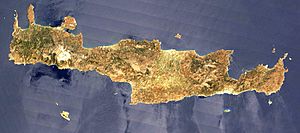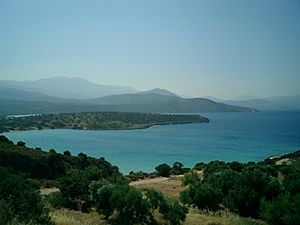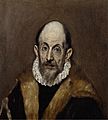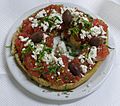Crete facts for kids
Quick facts for kids
Crete
Περιφέρεια Κρήτης
|
|
|---|---|
|
Region of Greece
|
|
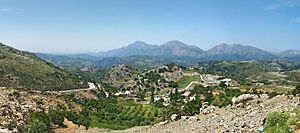
Crete
|
|
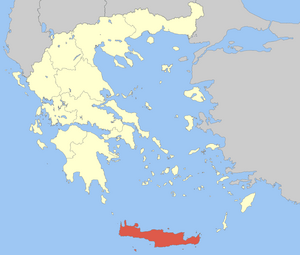 |
|
| Country | |
| Capital | Heraklion |
| Regional units |
List
Chania
Heraklion Rethymno Lasithi |
| Area | |
| • Total | 8,336 km2 (3,219 sq mi) |
| Highest elevation | 2,456 m (8,058 ft) |
| Population
(2011)
|
|
| • Total | 621,340 |
| • Density | 74.537/km2 (193.050/sq mi) |
| ISO 3166 code | GR-M |
Crete is the largest island in Greece. It is located in the Mediterranean Sea. Long ago, Crete had rich soil, a warm climate, and plenty of water. This helped its people, called the Cretans, focus on creating new things. They collected saffron from wild crocus flowers. Saffron was used for yellow dye, in food, and as medicine.
The Cretans learned many things from other cultures. They got rich cloth and jewels from the Egyptians. They learned how to use iron from the Hittites. From the Lydians, they learned about using money. The Phoenicians shared their alphabet, which is similar to what we use today.
Contents
Ancient Crete: The Minoan Civilization
About 4,700 years ago, the Minoan civilization began on Crete. This was a very advanced culture. The Minoans chose kings to rule them, each for seven years. These kings were known as Minos, and the people were called Minoans.
Knossos: Capital of the Minoans
The capital city of Crete was Knossos. The palace at Knossos was very grand. Its walls had beautiful decorating bands called friezes. A special symbol used often was the double-ax. This symbol is thought to show the king's power.
The king's throne was a simple seat with a high back. Nobles sat on benches covered with red and white plaster. The walls of the palace were painted with pictures of fish, dolphins, and seaweed. The queen even had her own private staircase. This allowed her to go upstairs without disturbing the men. Many rooms in the palace had huge jars, about six feet tall. These jars were used to store important things like wheat, oil, and dye.
Life in Ancient Crete
The Minoans had a unique way of life. They loved games, good food, and athletics. Music and beautiful clothes were also very important to them.
Minoan Religion and Beliefs
The palace of Knossos was also known as a labyrinth. A labyrinth is a maze where visitors could easily get lost. People said that a creature called the Minotaur lived there. The Minotaur was half bull and half man. Some stories say that young men and girls were sacrificed to this creature every year. Many historians believe that sacrifices to a bull were made because the Cretans thought the sound of an earthquake was an angry bull.
The Cretans also worshipped a goddess called the Great Mother Cybele, or the Snake Goddess. Statues of her often showed gold decorations and snakes wrapped around her arms. Snakes were believed to protect homes. Because of this, each house had a special room for snakes. Sometimes, a small table with grooves was placed for snakes to sip milk from a cup.
Games, Art, and Clothes
The Minoans were the first people to build stone theaters. In these theaters, many people watched parades and enjoyed music. Girls even took part in bullfighting. Unlike modern bullfighting, the Minoans did not kill the bull. A male fighter would grab the bull's horns, flip onto its back, and then land on the ground. Girls helped the bullfighter keep their balance during this daring act.
Women wore long, full skirts with very tiny waists. They also had fancy hairstyles and lots of jewelry. Men wore small belts around their waists. They used stones to shave and rubbed their teeth with pumice stone. Barbers would even burn off their body hair.
What the Cretans Ate
The Cretans ate fish, birds, and beef. They cooked barley in many ways. They also ate lots of cheese, nuts, and honey. They believed that only uncivilized people drank cow's milk. So, they drank goat's milk instead. The Cretans enjoyed singing, playing games, and guessing riddles. Even though they ate with their fingers, their food was cut into tiny pieces before being served.
Crete's Conquest
The Cretans were generally peaceful people. They did not build strong walls or fortifications to protect their cities from attacks. Around 1450 B.C., the Greek Mycenaeans attacked and captured Crete. This happened after Knossos, the capital, had been damaged by a powerful earthquake.
Images for kids
-
Minoan rhyton in the form of a bull, Heraklion Archaeological Museum
-
Minoan fresco from Knossos, Heraklion Archaeological Museum
-
Palace of Knossos
-
The Byzantines, under the general Damian, attack Crete but are defeated by the Saracens, c. 828, as depicted by Ioannes Scylitzes (see Skylitzes Chronicle).
-
The Siege of Candia, regarded as one of the longest sieges in history, lasted from 1648 to 1669.
-
Greek Orthodox (blue) and Cretan Muslim/Turkish (red) ethnic makeup of the island in 1861
-
Kara Musa Pasha mosque, Rethymno
-
German paratroopers landing on Crete during the Battle of Crete
-
The loggerhead sea turtle nests and hatches along the beaches of Rethymno and Chania and the gulf of Messara.
-
Venetian fortress in Heraklion
-
Chania cathedral
-
Rethymno Fortezza Mosque
-
Ruins of the Palace of Knossos
-
Archeological Museum of Chania
-
Pluto and Persephone in Heraklion Museum
-
Dakos, traditional Cretan salad
See also
 In Spanish: Creta para niños
In Spanish: Creta para niños


